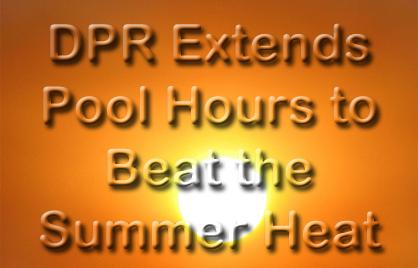
The National Weather Service has issued a Heat Advisory for the entire Washington metropolitan area for Thursday, June 9. Residents and visitors are encouraged to find a cooling center near you.
EOM Contact: Linda Wharton Boyd, (202) 727-5011
DPR Contact: John Stokes, (202) 288-7275
WASHINGTON, DC – The Northeast region of the country is in the middle of a triple-digit heat wave and Washington-area residents and visitors are feeling the effects in a major way.
The National Weather Service has issued a Heat Advisory for the entire Washington metropolitan area for Thursday, June 9. Residents and visitors are encouraged to find a cooling center near you. DC Recreation Centers, DC Public Libraries and DC Senior Wellness Centers are all great places to beat the heat and are open to the public. These locations provide not only a cool place to rest, but also provide water and activities.
In addition, to help residents beat the heat, the DC Department of Parks and Recreation (DPR) will open seven outdoor pools on Thursday, June 9, from 4:00 p.m. – 8:00 p.m. They are:
Ward 1
Banneker Recreation Center Pool
2500 Georgia Avenue NW
Ward 2
Jelleff Recreation Center Pool
3265 S Street NW
Ward 4
Upshur Recreation Center Pool
4300 Arkansas Avenue NW
Ward 5
Harry Thomas Recreation Center Pool
1743 Lincoln Road NE
Ward 6
Randall Pool
820 South Capitol Street SW
Ward 7
Fort Dupont Pool
800 Ridge Road SE
Ward 8
Anacostia Pool
1800 Anacostia Drive SE
There are multiple cooling locations available in each ward of the city. Visit DC.GOV to find one near you, or call the Mayor’s Citywide Call Center at 311.
In addition to the Heat Advisory, with the air-quality forecast as Code Orange for today, it is recommended that those with lung disease, asthma, small children and the elderly stay inside if at all possible to avoid unhealthy outdoor air.
DC Water and Fire and EMS officials want to remind the public that unauthorized fire-hydrant use is unlawful, dangerous and damaging.
You should know the difference between an advisory and a warning. An excessive-heat advisory issued by the National Weather Service means that extreme heat is likely. An excessive heat warning means that extreme heat is likely and can pose a threat to life if proper precautions are not taken.
In the event of extreme heat, you should take the following precautions:
- Stay indoors as much as possible.
- Turn on the air-conditioner or fan.
- DO NOT leave children or pets in vehicles.
- Pay special attention to young children, the elderly and the mentally ill.
- Drink plenty of water.
- Wear light-colored, lightweight and loose-fitting clothes.
- Apply sunscreen at least 20 minutes before going outside (SPF 15-30 is best).
- Limit exposure to the sun (the sun is most powerful between 10 a.m. and 3 p.m.).
- Watch for heat cramps, heat exhaustion and heat stroke.
- If you do not have access to a cool-temperature location, visit one of the District’s cooled indoor facilities referred to above.
Residents should also be reminded that these hot and humid conditions can cause many medical problems, such as heat stroke and exhaustion. The Centers for Disease Control and Prevention (CDC) consider heat stroke to be the most serious heat-related illness. According to CDC, “heat stroke occurs when the body becomes unable to control its temperature: the body's temperature rises rapidly, the sweating mechanism fails, and the body is unable to cool down. When heat stroke occurs, the body temperature can rise to 106 degrees Fahrenheit or higher within 10 to 15 minutes. Heat stroke can cause death or permanent disability if emergency treatment is not given.”
Symptoms of heat stroke:
- Hot, dry skin (no sweating)
- Hallucinations
- Chills
- Throbbing headache
- High body temperature
- Confusion/dizziness
- Slurred speech
Groups at greatest risk for heat-related illness:
- Infants
- Children up to four years of age
- People 65 years of age and older
- People who are overweight
- People who are ill or on certain medications.
Groups at greatest risk should be monitored carefully, and their environments should be regulated. The CDC recommends that those at greatest risk be closely monitored and visited at least twice a day to view for possible signs of heat exhaustion or heat stroke. Infants and young children should also be closely monitored.
For information about water for the homeless, contact United Planning Organization at (202) 399-7093. For additional information, visit the Emergency Information Center at 72hours.dc.gov.


